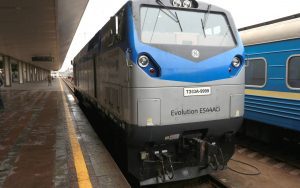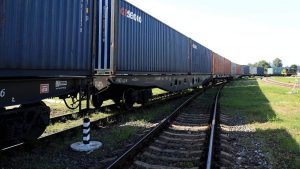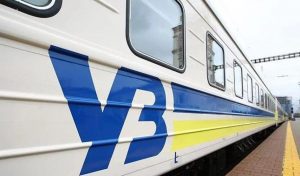
Ukrzaliznytsia by the end of 2020 expects to see a loss of UAH 12-14 billion.
“My personal vision: we will end this year with a loss of UAH 12-14 billion,” Head of Ukrzaliznytsia JSC Volodymyr Zhmak said at a briefing in Kyiv on Thursday.
At the same time, he said that the company counts on the support of international financial institutions.
“We are counting on our partners from the financial sector, first of all, international financial institutions,” he added.
In January-June 2020, Ukrzaliznytsia saw a net loss of UAH 8.792 billion, while for the same period in 2019 its net profit amounted to UAH 1.065 billion. At the same time, Ukrzaliznytsia’s net income from the sale of products (goods and services) in January-June 2020 amounted to UAH 35.623 billion (a decrease of 19.42% compared to the same period in 2019).

Head of JSC Ukrzaliznytsia Volodymyr Zhmak does not see the need for further purchase of diesel locomotives of the U.S. General Electric.
“As for cooperation with General Electric, today I do not see the need for further purchase of General Electric diesel locomotives. Our goal is to switch to electric locomotives, since it is much more cost efficient,” he said at a press conference on Thursday.
He said that Ukrzaliznytsia has eliminated the shortage of locomotives. “We have the first small achievements. For almost one month since the start of work, we have managed to eliminate the shortage of locomotives,” he said.
According to him, today, for the first time in a long time, Ukrzaliznytsia satisfies all transportation needs.
“There is not a single request for transportation that Ukrzaliznytsia did not satisfy. The market saw that we can transport. We can ship everything and do it quickly,” he added.

JSC Ukrzaliznytsia transported almost 80 million tonnes of cargo in July-September 2020, which is 2.7 million tonnes more than in the same period.
According to the press service of Ukrzaliznytsia on Thursday, October 22, transport volumes in domestic traffic increased by 11.3%, and in export by 1.8% for the specified period.
At the same time, it is noted that in the third quarter, the transportation of mineral construction materials, scrap ferrous metals, cement, and iron and manganese ores increased.
“The new tariff policy, which is now being implemented, will make rail freight transportation even more attractive for a wide range of customers. In particular, the company has already developed a new technology for the transportation of goods by block trains: three methods of calculating the tariff, the final cost depends on the volume of cargo and distance. The customer will be able to plan the turnover and speed of transportation,” Ukrzaliznytsia reported.

JSC Ukrzaliznytsia for the upcoming Independence Day of Ukraine will launch additional high-speed trains No. 224/223 Odesa-Kyiv and No. 168/167 Lviv-Odesa.
According to the company’s press service, the trains will be launched due to an increased demand for passenger transportation services on holidays.
Train No. 224/223 will transport passengers between Odesa and Kyiv on August 22 and 24.
Train No. 168/167 will transport passengers between Lviv and Odesa on August 22, 24, 26, 28 and 30.
KYIV, LVIV, ODESA, TRAIN, UKRZALIZNYTSIA

The Cabinet of Ministers on Wednesday intends to consider a bill on the list of 188 companies prohibited from privatization, according to the agenda of the government meeting. According to the text of the bill, the government allows the privatization of up to 50% of the shares of Naftogaz, Ukrzaliznytsia and Ukrposhta, but proposes to retain the state’s 100% share of corporate rights in National Nuclear Generating Company Energoatom, PrJSC Ukrhydroenergo, NEC Ukrenergo , Skhidny Ore Mining and Processing Plant (VostGOK), and Ukrainian Sea Ports Authority (USPA).
It is also proposed to include the SE Market Operator and the SE Guaranteed Buyer, created by the Cabinet of Ministers in 2019 in order to ensure the operation of the new electricity market, in the list of objects completely prohibited for privatization.
In addition, it is proposed to include in the specified list the state-owned enterprise Document, Ukraina Printing Plant for the production of securities, Kyiv offset factory, and Pivdenne (Yuzhne) Design Bureau.

JSC Ukrzaliznytsia (Kyiv) will cooperate with German logistics company Hamburger Hafen und Logistik AG (HHLA) on the development of intermodal railway transportation in Ukraine, and in future in the Baltics and Eastern Europe.
Infrastructure Minister of Ukraine Vladyslav Krykliy said on his Facebook page on Thursday that the companies have signed a memorandum of understanding on Thursday.
According to the minister, in the near future the German and Ukrainian carriers will have to agree on an action plan to determine and implement measures aimed at the improvement of services quality within the parties’ obligations, carry out regular monitoring, as well as eliminate problems.
The companies will also determine measures for improvement of the working capacity of the Odesa-Port rail station and the railway infrastructure with the aim of increasing cargo turnover in the port, take measures to improve effectiveness of commercialization of intermodal trains and agree on tariffs in line with international practices.
“In the long-term perspective they will have to decide on demand for rolling stock to provide intermodal transport services, reasonability of the use of light multisystem locomotives and determine the main requirements for location, financing and operation of terminals based on their growth,” Krykliy said.